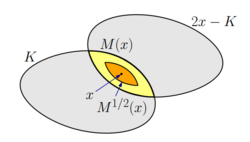Macbeath region
In mathematics, a Macbeath region is an explicitly defined region in convex analysis on a bounded convex subset of d-dimensional Euclidean space [math]\displaystyle{ \R^d }[/math]. The idea was introduced by Alexander Macbeath (1952)[1] and dubbed by G. Ewald, D. G. Larman and C. A. Rogers in 1970.[2] Macbeath regions have been used to solve certain complex problems in the study of the boundaries of convex bodies.[3] Recently they have been used in the study of convex approximations and other aspects of computational geometry.[4][5]
Definition
Let K be a bounded convex set in a Euclidean space. Given a point x and a scaler λ the λ-scaled the Macbeath region around a point x is:
- [math]\displaystyle{ {M_K}(x)=K \cap (2x - K) = x + ((K-x)\cap(x-K)) = \{k'\in K| \exists k \in K \text{ and } k'-x=x-k \} }[/math]
The scaled Macbeath region at x is defined as:
- [math]\displaystyle{ M_K^{\lambda}(x)=x + \lambda ((K-x)\cap(x-K)) = \{(1-\lambda)x+\lambda k'|k'\in K, \exists k\in K \text{ and } k'-x=x-k \} }[/math]
This can be seen to be the intersection of K with the reflection of K around x scaled by λ.
Example uses
- Macbeath regions can be used to create [math]\displaystyle{ \epsilon }[/math] approximations, with respect to the Hausdorff distance, of convex shapes within a factor of [math]\displaystyle{ O(\log^{\frac{d+1}{2}}(\frac{1}{\epsilon})) }[/math] combinatorial complexity of the lower bound.[5]
- Macbeath regions can be used to approximate balls in the Hilbert metric, e.g. given any convex K, containing an x and a [math]\displaystyle{ 0\leq\lambda\lt 1 }[/math] then:[4][6]
- [math]\displaystyle{ B_H\left(x,\frac{1}{2}\ln(1+\lambda)\right)\subset M^\lambda (x) \subset B_H\left(x,\frac{1}{2}\ln\frac{1+ \lambda}{1-\lambda}\right) }[/math]
- Dikin’s Method
Properties
- The [math]\displaystyle{ M_K^{\lambda}(x) }[/math] is centrally symmetric around x.
- Macbeath regions are convex sets.
- If [math]\displaystyle{ x,y \in K }[/math] and [math]\displaystyle{ M^{\frac{1}{2}}(x) \cap M^{\frac{1}{2}}(y) \neq \empty }[/math] then [math]\displaystyle{ M^{1}(y)\subset M^{5}(x) }[/math].[3][4] Essentially if two Macbeath regions intersect, you can scale one of them up to contain the other.
- If some convex K in [math]\displaystyle{ R^d }[/math] containing both a ball of radius r and a half-space H, with the half-space disjoint from the ball, and the cap [math]\displaystyle{ K \cap H }[/math] of our convex set has a width less than or equal to [math]\displaystyle{ \frac{r}{2} }[/math], we get [math]\displaystyle{ K \cap H \subset M^{3d(x)} }[/math] for x, the center of gravity of K in the bounding hyper-plane of H.[3]
- Given a convex body [math]\displaystyle{ K \subset R^d }[/math] in canonical form, then any cap of K with width at most [math]\displaystyle{ \frac{1}{6d} }[/math] then [math]\displaystyle{ C \subset M^{3d}(x) }[/math], where x is the centroid of the base of the cap.[5]
- Given a convex K and some constant [math]\displaystyle{ \lambda\gt 0 }[/math], then for any point x in a cap C of K we know [math]\displaystyle{ M^{\lambda}(x) \cap K \subset C^{1+\lambda} }[/math]. In particular when [math]\displaystyle{ \lambda\leq 1 }[/math], we get [math]\displaystyle{ M^{\lambda}(x) \subset C^{1+\lambda} }[/math].[5]
- Given a convex body K, and a cap C of K, if x is in K and [math]\displaystyle{ C \cap M'(x) \neq \empty }[/math] we get [math]\displaystyle{ M'(x)\subset C^2 }[/math].[5]
- Given a small [math]\displaystyle{ \epsilon\gt 0 }[/math] and a convex [math]\displaystyle{ K\subset R^d }[/math] in canonical form, there exists some collection of [math]\displaystyle{ O\left(\frac{1}{\epsilon^{\frac{d-1}{2}}}\right) }[/math] centrally symmetric disjoint convex bodies [math]\displaystyle{ R_1,....,R_k }[/math] and caps [math]\displaystyle{ C_1,....,C_k }[/math] such that for some constant [math]\displaystyle{ \beta }[/math] and [math]\displaystyle{ \lambda }[/math] depending on d we have:[5]
- Each [math]\displaystyle{ C_i }[/math] has width [math]\displaystyle{ \beta\epsilon }[/math], and [math]\displaystyle{ R_i \subset C_i \subset R_i^{\lambda} }[/math]
- If C is any cap of width [math]\displaystyle{ \epsilon }[/math] there must exist an i so that [math]\displaystyle{ R_i \subset C }[/math] and [math]\displaystyle{ C_i^{\frac{1}{\beta^2}} \subset C \subset C_i }[/math]
References
- ↑ Macbeath, A. M. (September 1952). "A Theorem on Non-Homogeneous Lattices". The Annals of Mathematics 56 (2): 269–293. doi:10.2307/1969800.
- ↑ Ewald, G.; Larman, D. G.; Rogers, C. A. (June 1970). "The directions of the line segments and of the r-dimensional balls on the boundary of a convex body in Euclidean space". Mathematika 17 (1): 1–20. doi:10.1112/S0025579300002655.
- ↑ 3.0 3.1 3.2 Bárány, Imre (June 8, 2001). "The techhnique of M-regions and cap-coverings: a survey". Rendiconti di Palermo 65: 21–38.
- ↑ 4.0 4.1 4.2 Abdelkader, Ahmed; Mount, David M. (2018). "Economical Delone Sets for Approximating Convex Bodies". 16th Scandinavian Symposium and Workshops on Algorithm Theory (SWAT 2018) 101: 4:1–4:12. doi:10.4230/LIPIcs.SWAT.2018.4.
- ↑ 5.0 5.1 5.2 5.3 5.4 5.5 Arya, Sunil; da Fonseca, Guilherme D.; Mount, David M. (December 2017). "On the Combinatorial Complexity of Approximating Polytopes". Discrete & Computational Geometry 58 (4): 849–870. doi:10.1007/s00454-016-9856-5.
- ↑ Vernicos, Constantin; Walsh, Cormac (2021). "Flag-approximability of convex bodies and volume growth of Hilbert geometries". Annales Scientifiques de l'École Normale Supérieure 54 (5): 1297–1314. doi:10.24033/asens.2482.
Further reading
- Dutta, Kunal; Ghosh, Arijit; Jartoux, Bruno; Mustafa, Nabil (2019). "Shallow Packings, Semialgebraic Set Systems, Macbeath Regions, and Polynomial Partitioning". Discrete & Computational Geometry 61 (4): 756–777. doi:10.1007/s00454-019-00075-0. https://drops.dagstuhl.de/opus/volltexte/2017/7199/.
 |


